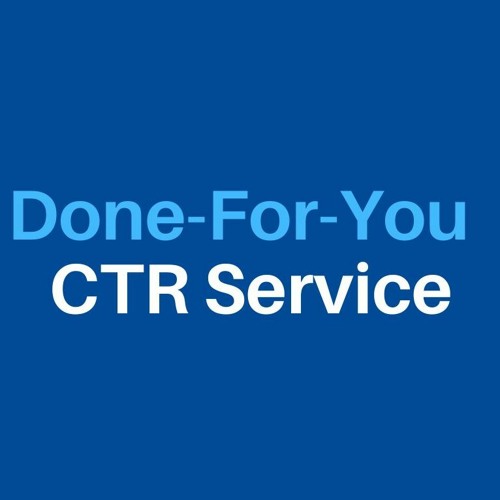How to Determine the Impact of CTR Control on Your Marketing
Recognizing the nuances of click-through price (CTR) adjustment in advertising is necessary for companies making every effort for authentic customer engagement. By checking out essential metrics such as conversion prices and bounce rates, online marketers can reveal potential inconsistencies that may develop from artificial enhancements.
Recognizing CTR Manipulation
Comprehending CTR adjustment is vital for marketing experts seeking to enhance their projects and ensure data stability. Click-through price (CTR) refers to the ratio of individuals that click a particular link to the complete number of users who watch the advertisement or content. Control of this metric can happen via numerous means, including using deceptive advertising and marketing techniques, click ranches, or automated robots. These techniques can artificially inflate CTR numbers, resulting in misguided advertising and marketing methods and misallocation of sources.
The effects of CTR adjustment extend past plain information distortion; they can undermine count on digital advertising. When businesses depend on filled with air metrics, they may buy ineffective campaigns, eventually harming their return on investment. Additionally, systems might punish marketers participating in such methods, resulting in additional implications for their marketing efforts.
To effectively deal with CTR manipulation, marketing experts must develop a comprehensive understanding of their information resources and analytics devices. By utilizing advanced monitoring techniques and inspecting traffic sources, they can identify uneven patterns and make certain that their efficiency metrics show authentic user involvement - GMB CTR Manipulation. This alertness is critical for promoting long-lasting success in a progressively competitive electronic landscape
Secret Metrics to Evaluate
Efficient evaluation of essential metrics is crucial for assessing real performance of advertising and marketing projects and spotting prospective CTR adjustment. One main metric to take into consideration is the Click-Through Rate (CTR) itself, which stands for the proportion of customers who click on an ad to the complete number of individuals that view it. An unexpected spike in CTR might indicate control, necessitating more investigation.
Furthermore, keeping track of conversion prices is important. A high CTR with a low conversion price can signify that the clicks are not real or that the targeting is misaligned (GMB CTR Manipulation). In a similar way, assessing bounce rates can give understanding into customer interaction; a high bounce rate after a click may recommend that the website traffic is not quality-driven.

Devices for Dimension

Furthermore, A/B screening tools such as Optimizely or VWO can promote testing with numerous ad variations to identify which components drive higher CTR. These devices allow marketing experts to evaluate real-time efficiency and make data-driven modifications. Social media analytics devices, like Hootsuite or Sprout Social, can also contribute in understanding CTR within social systems, offering understandings right into audience actions and engagement fads.
In addition, warm mapping devices, such as Hotjar, can reveal how individuals engage with advertisements, helping to identify where enhancements can be made. Incorporating these tools develops a robust measurement structure, allowing online marketers to recognize the impacts of CTR control properly. Inevitably, the appropriate option of dimension tools is critical for making educated advertising and marketing choices and maximizing project efficiency.

Examining Long-term Results
One need to take into consideration the lasting impacts of CTR manipulation on total advertising performance, as temporary gains can commonly mask deeper effects. Over time, synthetically blew up click-through prices may result in decreased depend on from customers and search engines alike. When individuals continuously run into deceitful techniques, they might end up being hesitant to engage with the brand, resulting in lower conversion rates in the future.
Additionally, algorithm updates from platforms such as Google are created to prioritize authentic interaction over filled with air metrics. Subsequently, organizations that count find more information on CTR adjustment might discover themselves penalized, causing a decrease in natural reach and exposure. This can have a cascading effect on brand name reputation and consumer loyalty, ultimately threatening the very goals that the first adjustment sought to achieve.
Additionally, the information collected from helpful resources adjusted CTR might misguide marketing experts in their approach advancement. Counting on skewed information can cause misdirected campaigns that fall short to resonate with the target market, resulting in thrown away sources and missed opportunities. It is crucial for marketing experts to assess the long-lasting implications of CTR manipulation and focus on lasting, honest involvement methods for lasting success.
Moral Considerations in CTR Adjustment
In the realm of electronic advertising and marketing, honest considerations bordering CTR adjustment are critical. While the desire to boost click-through rates (CTR) can lead to temporary gains, the potential long-term effects on brand stability and consumer trust can not be neglected.
Furthermore, honest worries reach conformity with laws such as the Federal Profession Payment (FTC) standards, which mandate openness in advertising and marketing. Falling short to stick to these criteria can reveal organizations to lawful implications and harm their track record. Online marketers need to think about the ramifications of their methods on user experience and the broader industry landscape.
Additionally, the surge of expert system and automation in marketing presents further moral dilemmas. The potential for mathematical prejudice or the exploitation of customer information questions concerning responsibility and justness. Inevitably, honest marketing practices need to prioritize transparency, honesty, and respect for the consumer, cultivating long-term relationships that go beyond mere metrics like CTR. Stabilizing performance with ethics is essential for lasting success in the digital industry.
Verdict
In verdict, gauging the influence of CTR adjustment on advertising needs a detailed analysis of crucial metrics, including click-through rates, conversion prices, and bounce prices. Ultimately, a data-driven method makes certain that advertising and marketing methods are efficient and lined up with genuine customer communications.
Comprehending the nuances of click-through price (CTR) control in marketing is important for businesses making every effort for authentic user involvement.Efficient analysis of look at here now vital metrics is important for assessing the true efficiency of marketing projects and discovering potential CTR adjustment.One should consider the long-lasting effects of CTR control on overall advertising and marketing performance, as temporary gains can typically mask deeper ramifications.In the realm of electronic marketing, honest considerations surrounding CTR manipulation are extremely important.In final thought, gauging the effect of CTR adjustment on marketing calls for an extensive evaluation of crucial metrics, including click-through prices, conversion rates, and bounce prices.
Comments on “The Influence of a CTR Manipulation Press Release on Brand Awareness”